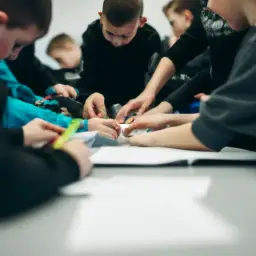Are you struggling to stay motivated in a virtual learning environment? Do you find yourself easily giving up on tasks or feeling overwhelmed by the challenges of online learning? Building grit, or the ability to persevere through difficult situations, is essential for success in any learning environment, virtual or otherwise.
Fortunately, there are proven strategies you can implement to develop your grit and thrive in a virtual learning setting. In this article, we will explore 13 strategies for building grit in a virtual learning environment.
From developing a growth mindset and setting goals to creating a supportive learning community and practicing self-care, these strategies will help you stay motivated and focused on your academic goals. Whether you are a student, teacher, or parent navigating the challenges of virtual learning, these strategies will provide you with the tools you need to succeed.
So, let’s dive in and discover how to build grit in a virtual learning environment!
Key Takeaways
- Building grit is crucial for success in virtual learning and can be developed with practice and perseverance.
- Developing a growth mindset and setting SMART goals are essential for cultivating grit and achieving success.
- Tracking progress and joining a virtual learning community can provide a supportive environment for learning and staying motivated.
- Practicing self-care, balancing immediate needs with future aspirations, and consistently persevering are key to developing grit and achieving academic success in a virtual learning environment.
Understanding the Importance of Grit in a Virtual Learning Environment
Grit is like a sturdy anchor that keeps you steady in the midst of stormy virtual learning seas. It’s the perseverance and passion for long-term goals that drives you forward even when faced with obstacles.
In a virtual learning environment, cultivating grit is essential for success. The benefits of grit are numerous. It helps you stay motivated and focused on your goals, even when faced with setbacks. It also helps you develop resilience, which is crucial in a virtual learning environment where challenges are inevitable.
To cultivate grit, set challenging yet achievable goals, practice self-discipline, and maintain a positive mindset. Remember that grit is not something you’re born with, but rather something you develop over time with practice and perseverance.
Developing a Growth Mindset
By embracing a growth mindset, you can help yourself develop the belief that your abilities can be improved with effort and hard work. This is in contrast to a fixed mindset, where individuals believe their abilities and traits are set in stone and cannot be changed.
Here are three ways to cultivate a growth mindset in a virtual learning environment:
-
Embrace challenges: Instead of shying away from difficult tasks, approach them with a positive attitude and see them as opportunities to learn and grow.
-
Learn from mistakes: Instead of being discouraged by failures, view them as opportunities for growth and learning. Reflect on what went wrong and what you can do differently next time.
-
Encourage positive self-talk: The way you talk to yourself can have a big impact on your mindset. Instead of negative self-talk, try to focus on positive affirmations and self-encouragement.
By adopting a growth mindset and encouraging positive self-talk, you can develop the resilience and perseverance needed to succeed in a virtual learning environment. Remember, your abilities are not set in stone – with hard work and effort, you can continuously improve and grow.
Setting Goals
Context:
Setting goals
Input:
So you want to set goals in your virtual learning environment? Great! This subtopic will guide you through SMART goal-setting, the difference between long-term and short-term goals, and how to track your progress.
By the end of this discussion, you’ll have a clear understanding of how to set achievable goals and monitor your growth towards achieving them.
SMART Goal-Setting
You’ll want to set SMART goals to help you achieve success in your virtual learning environment. SMART stands for Specific, Measurable, Attainable, Relevant, and Time-bound. Effective strategies for goal achievement include setting goals that are specific, measurable, and attainable. The goals should be relevant to your current situation and have a deadline for completion.
To make the goal-setting process easier, use the following table as a guide:
| Specific | Measurable | Attainable | Relevant |
|---|---|---|---|
| What exactly do you want to achieve? | How will you track your progress? | Is the goal realistically achievable? | Does the goal align with your overall objectives? |
| Time-bound |
|---|
| When do you want to achieve your goal? |
Setting SMART goals can help you stay motivated and focused on your studies. By breaking down your goals into specific, measurable, attainable, relevant, and time-bound objectives, you’ll be able to track your progress and adjust your study habits accordingly. Remember, the key to success is to set realistic goals that align with your overall objectives, and to stick to a schedule that allows for consistent progress.
Long-Term vs. Short-Term Goals
When setting goals for yourself, it’s important to consider both long-term and short-term objectives. Short term sacrifices may be necessary to achieve long term gains. You may need to give up some immediate pleasures or comforts to attain your goals in the future. However, balancing immediate needs with future aspirations can be challenging, especially in a virtual learning environment where distractions are abundant.
To help you stay on track with your long-term goals, it’s essential to break them down into smaller, more manageable short-term goals. This way, you can monitor your progress and adjust your actions accordingly. Short-term goals can also serve as motivators, giving you a sense of accomplishment and satisfaction as you achieve them.
Remember, every small step counts towards achieving your long-term goals, so keep taking action and stay committed to your vision.
Tracking Progress
Tracking your progress is essential to achieving your goals and staying motivated along the way. Goal tracking and progress monitoring can help you stay on track and make adjustments when necessary. In a virtual learning environment, it can be easy to lose sight of your goals and become overwhelmed with the amount of work you have to do. By tracking your progress, you can break down your goals into manageable tasks and stay focused on what you need to accomplish.
One effective way to track your progress is by using a goal-tracking table. This table can help you visualize your progress and keep you motivated as you work towards achieving your goals. The table can be divided into two columns and four rows. The first column can include your goals, while the second column can be used to track your progress. The four rows can be used to track your progress on a weekly, monthly, quarterly, and yearly basis. As you complete each task, you can mark it off in the table and see how far you have come. By keeping track of your progress, you can stay motivated and focused on achieving your goals in a virtual learning environment.
Creating a Supportive Learning Community
Joining a virtual learning community can be helpful in fostering a sense of belonging and building support among students. Virtual socialization with peers who share similar interests and goals can provide a supportive environment for learning.
Through online discussions, group projects, and virtual study sessions, students can connect with each other and build relationships that can help them stay motivated and engaged in their studies. In a virtual learning environment, it can be easy to feel isolated and disconnected from the rest of the class.
However, by participating in a supportive learning community, students can feel a sense of accountability and responsibility to their peers. Peer support can take many forms, from offering encouragement and motivation to providing feedback on assignments and projects.
Ultimately, building a strong support network can help students develop the grit and determination they need to succeed in a virtual learning environment.
Practicing Self-Care
Now it’s time to focus on your own well-being by practicing self-care. To start, establish a routine that works for you and stick to it.
Taking breaks throughout the day can also help you recharge and refocus. And don’t forget to engage in physical activity to get your blood flowing and boost your mood.
Remember, taking care of yourself is just as important as your academic success.
Establishing a Routine
Creating a consistent daily schedule can help you develop a sense of structure and stability in your virtual learning environment. This can be especially helpful if you are struggling with motivation and finding it difficult to stay on track with your studies. By sticking to a routine, you can establish a sense of normalcy and control, which can help you feel more focused and productive.
To create a daily schedule, start by identifying the times of day that you are most alert and productive. This will vary from person to person, so take some time to experiment and find what works best for you. Once you have a general idea of your peak hours, use the following table to help you plan out your day:
| Time | Activity |
|---|---|
| 6:00-7:00am | Wake up and get ready for the day |
| 7:00-8:00am | Eat breakfast and review your schedule |
| 8:00-10:00am | Work on your most challenging task |
| 10:00-10:30am | Take a break and stretch |
| 10:30-11:30am | Work on a less challenging task |
| 11:30am-12:30pm | Take a lunch break |
| 12:30-2:30pm | Work on another challenging task |
| 2:30-3:00pm | Take a break and go for a walk |
| 3:00-4:00pm | Work on a less challenging task |
| 4:00-5:00pm | Review your progress and plan for the next day |
| 5:00-6:00pm | Wrap up your work and wind down for the day |
By following a schedule like this, you can create structure and consistency in your day, which can help you stay focused and motivated. Remember, it’s important to be flexible and make adjustments as needed, but having a general routine can be a great way to build grit in your virtual learning environment.
Taking Breaks
To enhance your productivity and maintain focus, it’s crucial that you take regular breaks during your daily routine.
One effective technique is the Pomodoro technique, which involves working for 25 minutes and then taking a 5-minute break. This cycle is repeated four times, and then a longer break of 15-30 minutes is taken.
By taking these short breaks, you’re giving your brain time to rest and recharge, which ultimately leads to improved focus and productivity when you return to your work.
Another type of break that can be beneficial is a mindfulness break. This involves taking a few minutes to focus on your breath and clear your mind of any distractions.
Mindfulness breaks can help reduce stress and anxiety, improve focus and concentration, and increase overall well-being.
By incorporating these breaks into your routine, you can build grit by improving your ability to stay focused and motivated throughout the day.
Engaging in Physical Activity
Engaging in physical activity can be a fun and energizing way to boost your productivity and refocus your mind in a virtual learning environment. With the limitations of being indoors, it’s important to find ways to incorporate outdoor activities into your routine.
You can take a walk or run around your neighborhood, go for a bike ride, or even do some gardening. Getting outside and moving your body can help reduce stress and improve your overall mood, which can lead to better focus and concentration during virtual classes.
Another great option for engaging in physical activity in a virtual learning environment is to participate in virtual fitness classes. Many gyms and fitness studios are offering online classes that you can take from the comfort of your own home. These classes range from yoga and pilates to high-intensity interval training (HIIT) and dance classes.
Not only will you get a great workout, but it can also be a fun way to connect with others and break up the monotony of sitting in front of a computer screen all day. So, whether you prefer outdoor activities or virtual fitness classes, make sure to incorporate physical activity into your daily routine to help build grit and improve your overall well-being.
Staying Motivated
Staying motivated in a virtual learning environment can be challenging, but there are strategies you can use to help you stay on track. One key approach is to set achievable goals and reward yourself for your progress.
To do this, start by breaking down your larger goals into smaller, more manageable tasks. This will make it easier to see progress and avoid feeling overwhelmed.
Here are some additional tips to help you stay motivated:
- Celebrate your achievements, even the small ones. Give yourself a pat on the back or a high-five when you complete a task or reach a milestone.
- Connect your learning to something meaningful, such as a future career or personal growth. Knowing why you’re doing something can help you stay motivated.
- Treat yourself for a job well done. This could be something as simple as taking a break to watch your favorite TV show or buying yourself a small treat.
Remember, it’s important to be kind to yourself and recognize that motivation can ebb and flow. If you find yourself struggling, take a step back and reassess your goals. Adjust them as needed and keep moving forward. You’ve got this!
Frequently Asked Questions
How can virtual learning environments be improved to better promote grit?
To improve virtual learning environments and better promote grit, you should focus on increasing motivation and fostering resilience in your students.
You can start by providing clear goals and expectations for each lesson, so students have a sense of purpose and direction. Encourage them to take ownership of their learning by offering opportunities for self-reflection and goal-setting.
To foster resilience, provide challenging tasks that push students out of their comfort zones, but also offer support and feedback along the way. Encourage a growth mindset by emphasizing the importance of effort and perseverance over innate ability.
By focusing on motivation and resilience, you can help students develop the grit they need to succeed in virtual learning environments and beyond.
What are some common barriers to developing grit in a virtual learning environment?
Common barriers to developing grit in a virtual learning environment may include a lack of structure, difficulty with time management, and a perceived lack of accountability or motivation.
You may find yourself struggling to stay on track without the physical presence of a teacher or classmates to hold you accountable, or feeling overwhelmed by the amount of work to be completed without a clear schedule or plan.
Overcoming these obstacles may involve setting clear goals and deadlines for yourself, utilizing tools and resources provided by your virtual learning platform, and seeking support from peers or mentors. It may also require a shift in mindset, recognizing that the challenges presented by a virtual learning environment can actually provide opportunities for growth and development of grit.
How does grit impact academic performance in a virtual learning environment compared to traditional classroom settings?
When it comes to academic performance, grit plays a significant role in both virtual learning and traditional classroom settings. Studies have shown that students who possess grit tend to perform better academically, regardless of the learning environment.
However, there may be some differences in how grit impacts success in virtual learning compared to the classroom. In a virtual learning environment, students may face unique challenges, such as distractions at home or technical difficulties, that require a higher level of perseverance and resilience.
On the other hand, in a traditional classroom setting, students may have more opportunities for face-to-face interaction with their peers and teachers, which can provide additional support and motivation.
Ultimately, the correlation between grit and success is important in both virtual learning and classroom learning, and it’s essential that educators continue to focus on developing grit in their students to help them achieve their academic goals.
Can grit be taught or is it a natural trait that some students possess?
When it comes to teaching grit, the debate over nature vs. nurture is ongoing. Some believe that grit is a natural trait that some students possess, while others argue that it can be taught.
In the context of online education, teaching grit may be even more important as students may face additional challenges such as lack of motivation, distractions, and isolation. While some students may naturally possess grit, it is still important for educators to focus on teaching and developing this trait in all students.
By providing opportunities for students to challenge themselves, setting achievable goals, and emphasizing the importance of perseverance, educators can help students develop grit and succeed in their online education.
How can parents and caregivers support the development of grit in virtual learners?
As a parent or caregiver of a virtual learner, your involvement is crucial in fostering resilience and developing grit.
One way to support your child is by providing a safe and supportive environment where they feel comfortable taking risks and making mistakes. Encourage them to persevere through challenges and setbacks, and praise their effort rather than just their successes.
Help them set achievable goals and celebrate their progress along the way. Additionally, make sure they have access to resources and support systems, such as teachers, tutors, and peers, who can provide guidance and encouragement.
By being an active and supportive presence in your child’s virtual learning experience, you can help them develop the grit and resilience they need to succeed.
Conclusion
So, there you have it! You now have 13 proven strategies for building grit in a virtual learning environment.
As you navigate through your online classes, remember that developing a growth mindset, setting goals, creating a supportive learning community, practicing self-care, and staying motivated are all essential for building grit.
By incorporating these strategies into your daily routine, you’ll not only become a more resilient learner, but you’ll also be better equipped to face any challenges that come your way.
So, go ahead and start implementing these strategies today, and watch as your grit and determination soar to new heights!






































































































